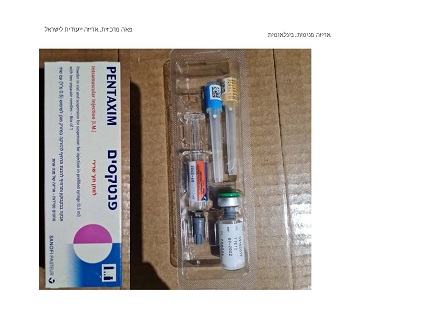Quest for the right Drug

פנטקסים PENTAXIM (CONJUGATED TO TETANUS PROTEIN, DIPHTHERIA TOXOID, FILAMENTOUS HAEMAGGLUTININ (FHA), HAEMOPHILUS INFLUENZAE TYPE B POLYSACCHARIDE, PERTUSSIS TOXOID (PT), POLIO TYPE I (MOHONEY), POLIO TYPE II ( M.E.F.1), POLIO TYPE III (SAUKETT), TETANUS TOXOID)
תרופה במרשם
תרופה בסל
נרקוטיקה
ציטוטוקסיקה
צורת מתן:
תוך-שרירי : I.M
צורת מינון:
אבקה ותרחיף להכנת תרחיף להזרקה : POWDER AND SUSPENSION FOR SUSPENSION FOR INJECTION
עלון לרופא
מינוניםPosology התוויות
Indications תופעות לוואי
Adverse reactions התוויות נגד
Contraindications אינטראקציות
Interactions מינון יתר
Overdose הריון/הנקה
Pregnancy & Lactation אוכלוסיות מיוחדות
Special populations תכונות פרמקולוגיות
Pharmacological properties מידע רוקחי
Pharmaceutical particulars אזהרת שימוש
Special Warning עלון לרופא
Physicians Leaflet
Adverse reactions : תופעות לוואי
4.8 Undesirable effects The adverse events are ranked under headings of frequency using the following convention: • Very common (≥1/10) • Common (≥1/100 to <1/10) • Uncommon (≥1/1000 to <1/100) • Rare (≥1/10 000 to 1/1000) • Very rare (<1/10 000) • Not known (cannot be estimated from the available data). Based on spontaneous reporting, these adverse events have been very rarely reported following commercial use of Pentaxim. Because events are reported voluntarily from a population of uncertain size, it is not always possible to reliably estimate their frequency or establish a causal relationship to vaccine exposure. In clinical studies in infants who received Pentaxim as a primary series the most frequently reported reactions are local reactions at the injection site, abnormal crying, irritability and fever. These signs and symptoms usually occurred within 48 hours after vaccination. They resolved spontaneously without requiring specific treatment. After the primary series, the frequencies of injection site reactions tend to increase with the booster dose. Immune system disorders • Not Known: − Anaphylactic reactions such as face oedema, Quincke’s oedema or shock. Metabolism and nutrition disorders • Very common: − Anorexia (feeding disturbances) Psychiatric disorders • Very common: − Nervousness (irritability) − Abnormal crying • Common: − Insomnia (sleep disturbances) • Uncommon: − Prolonged inconsolable crying Nervous system disorders • Very common: − Somnolence (drowsiness) • Not Known: − Convulsions with or without fever − Hypotonic reaction or hypotonic-hyporesponsive episodes (HHE) Gastro-intestinal disorders • Very common: − Vomiting • Common: − Diarrhoea Skin and subcutaneous tissue disorders • Not Known: − Rash − Urticaria General disorders and administration site conditions • Very common: − Redness at the injection site − Pyrexia, (fever) ≥38°C − Injection site swelling − Injection site pain • Common: − Induration at the injection site • Uncommon: − Pyrexia, (fever) ≥39°C − Redness and swelling ≥5cm at the injection site • Rare: − Pyrexia >40°C (high fever) − Oedematous reaction affecting one or both lower limbs may occur following vaccination with Haemophilus influenzae type b containing vaccines. If this reaction occurs, it does so mainly after primary injections and is observed within the first few hours following vaccination. Associated symptoms may include cyanosis, redness, transient purpura and severe crying. All events resolve spontaneously without sequelae within 24 hours. • Not Known: − Large injection site reactions (> 50 mm), including extensive limb swelling from the injection site beyond one or both joints have been reported in children. These reactions start within 24- 72 hours after vaccination, may be associated with erythema, warmth, tenderness or pain at the injection site, and resolve spontaneously within 3-5 days. The risk appears to be dependent on the number of prior doses of acellular pertussis containing vaccine, with a greater risk following the 4th and 5th doses. There have been very rare reports of brachial neuritis and Guillain-Barré Syndrome after administration of other tetanus toxoid containing vaccines. Additional information on special populations Apnoea in very premature infants (≤ 28 weeks of gestation) (see section 4.4). Reporting of suspected adverse reactions Reporting suspected adverse reactions after authorisation of the medicinal product is important. It allows continued monitoring of the benefit/risk balance of the medicinal product. Any suspected adverse events should be reported to the Ministry of Health (www.health.gov.il) according to the National Regulation by using an online form https://sideeffects.health.gov.il

שימוש לפי פנקס קופ''ח כללית 1994
לא צוין
תאריך הכללה מקורי בסל
לא צוין
הגבלות
לא צוין
מידע נוסף
